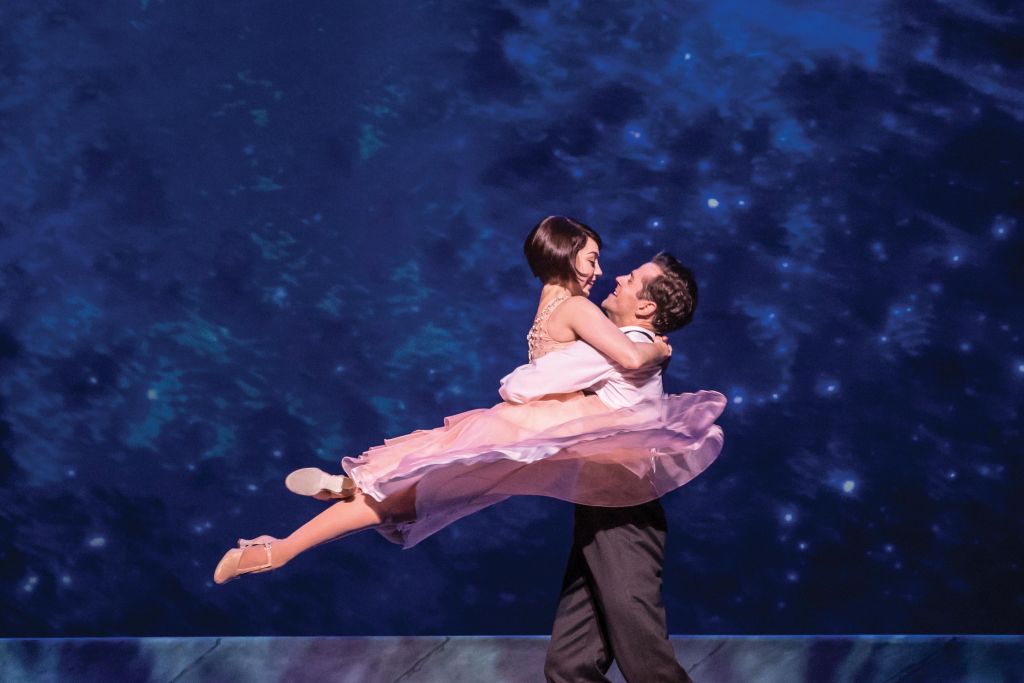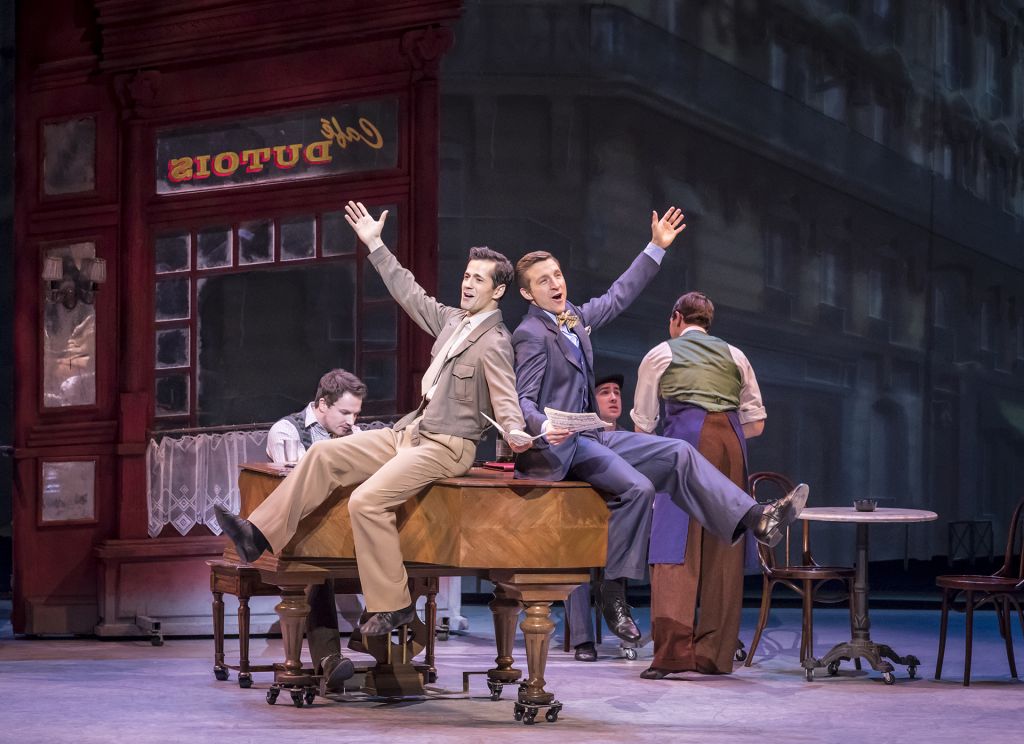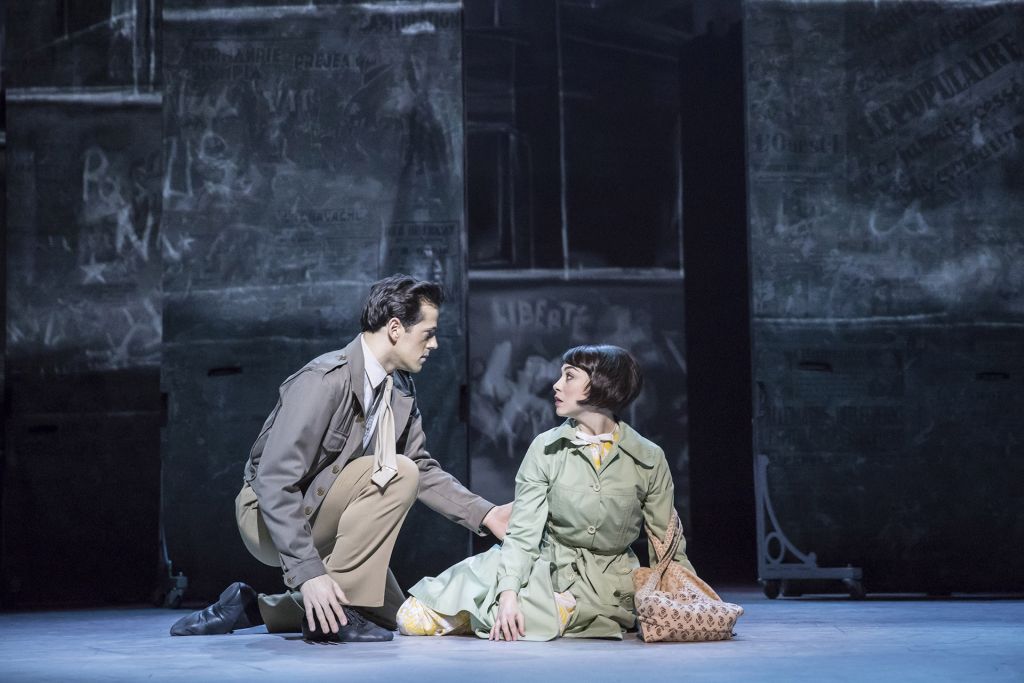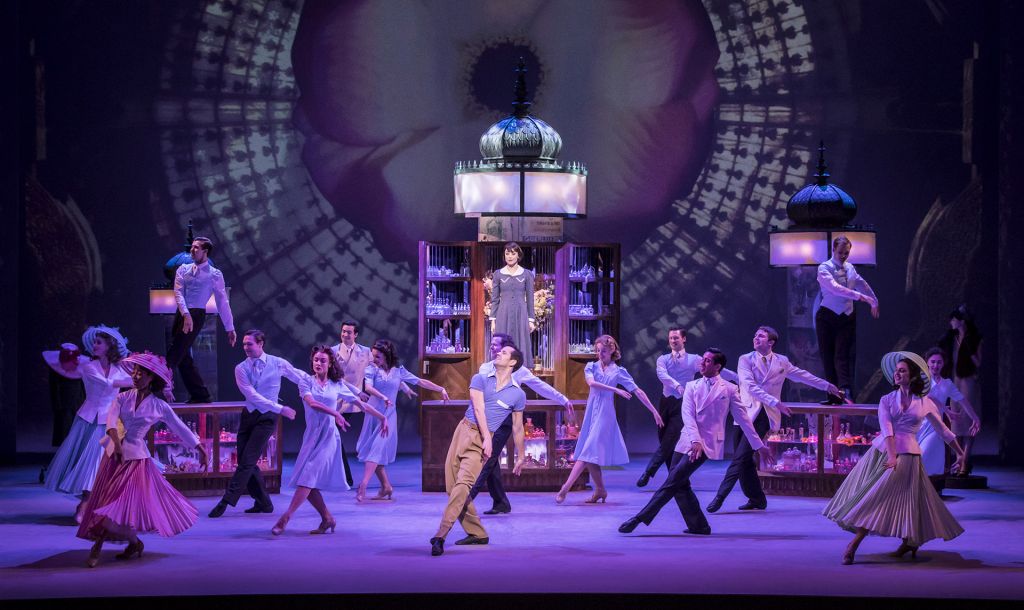On Friday, November 2, a live capture of the Tony Award-winning An American in Paris The Musical kicks off Great Performances’ Broadway’s Best series, offering audiences another chance to behold the rhapsodic dance and song spectacle choreographed and directed by Christopher Wheeldon.
By Britt Stigler for ALL ARTS
Filmed during its West End engagement in London, the live capture of the musical retains the magic of the stage production, which features Robert Fairchild as a lithe, energetic Jerry Mulligan and Leanne Cope as the enigmatic Lise Dassin. As with the original 1951 film version, the musical, which opened at the Théâtre du Châtelet in Paris in 2014, deftly navigates the sinews of the heart as Jerry, an American who has decided to stay in Paris to pursue his passion for painting, falls for Lise, a ballet dancer with obligations to another man.

Robert Fairchild and Leanne Cope in an “An American In Paris” rehearsal image from Three Mills Rehearsal studios, London, UK, 2017. Credit: Johan Persson.
Injecting the pleasant plot of the original with contemporary color, the updated version deepens the entanglement of its cast (we won’t give anything away here), a task that Wheeldon meets with intricate staging and choreography that tightens and releases the tension between the characters as the story unfolds. Wheeldon’s stage direction is matched by thoughtful set design from Bob Crowley. All but one of the film’s tap-heavy dance sequences have been replaced with robust ballet movements, but the adaptation retains the famous music and lyrics of George Gershwin and Ira Gershwin.
Our colleagues at ALL ARTS spoke with Fairchild about stepping into Gene Kelly’s shoes, the transition from ballet to Broadway and more.
ALL ARTS: How did this all get started? What’s the genesis of you stepping into this role?
Robert Fairchild: I had been a dancer with the New York City Ballet for a couple of years. Christopher Wheeldon came up to me at a New York City Ballet gala, where I was dancing a Fred Astaire tribute, and I was tapping. And he said, “Can you sing?” And I said, “Who’s listening?” And he had me come in and audition and told me about the project, and I was like, oh, my God, this is huge, and worked my butt off for a year.
It was about a year audition process as they went around the world looking for people who could dance ballet, sing and act. And I just stayed in the running the whole time, and then the last final callback I remember the next day I had my dress rehearsal as the prince in “Sleeping Beauty” at the New York City Ballet. So meanwhile prepping for “Sleeping Beauty,” I was doing acting lessons, singing lessons and auditioning for the show. And I remember coming up at the intermission break, and I got a missed call from Chris Wheeldon, and it said, “Hey, I’m actually looking for Jerry Mulligan; I think I got the wrong number.” And he said, “Rob, it’s yours if you want it.” And I was like, “Are you kidding? Do I want it? This is like the dream I have for myself.”
My childhood dream was to follow in the footsteps of Gene Kelly. So it’s interesting that I went the ballet route, and the ballet route was what put me in touch with Christopher Wheeldon. He wanted to do a ballet heavy version of “An American in Paris,” and I thought, “I wouldn’t have been right for this had I not chose the path of ballet.” So I’m at this place where I’ve been exposed to my lifelong dream of doing song and dance musical theater, so much so that it pulled me out of the ballet world.
AA: What was that transition like?
RF: I went back to New York City Ballet after a year on Broadway. It just felt different. I didn’t feel like I really belonged anymore. The narrative of the stories, or the kinds of things I wanted to do, you didn’t do at New York City Ballet. I wanted to dive into character work, and it’s just not something you really did. It was all about the steps and turning out all these amazing ballets. So it was really kind of obvious to me that I had started to feel a little differently about working in the ballet company. Then London came along and instilled my passion for this next phase of my career, so I just followed the momentum.
AA: And technically, how is it different preparing for ballet repertoire versus a full-length Broadway show?
RF: Well, ballet physicality and physicality for singing and acting could not be more polar opposite — like opposite ends of the spectrum. And it makes it really difficult when you’re dancing, dancing, dancing, dancing, five-six-seven-eight: sing. What do you do? How do you train? What are the tricks that you figure out that work for your body in order to open up? Because dancing you have to protect yourself; you’re up, you’re lifted, so you can do anything at one moment, and then you just have to completely let it go and find a different kind of breath and breathing. And I figured it out, but it was an investigation for sure.

“An American In Paris” rehearsal image from Three Mills Rehearsal studios, London, UK, 2017. Credit: Johan Persson.
AA: What was it like acting on stage and using your voice and all of that?
RF: As soon as you open up your voice onstage it’s like truth serum. As a dancer and doing so many different ballets, I’d never felt so exposed until I tried opening up my mouth on stage. And it’s another beast. It’s another level of specificity and detail and truth and honesty and genuineness, and, yeah, it’s truth serum.
The crazy thing is you have to know exactly what you’re going to say, but you can’t know in the moment. And that’s just bizarre. It’s spontaneity. It’s being in the moment and reacting. I know what I have to say, but what am I getting in front of me? It’s much more responsive. If offer my hand on five, you take on six, we’re up in the air on seven, that’s how dance works, otherwise, somebody gets hurt. If I decide to offer on seven one night because I’m feeling a little into the music or something, and I get carried away, you might land on the ground and hurt yourself. So there are certain parameters in the dance world that have to be more structured, and being an actor, I don’t have to worry about you falling on the floor. I can give you something different, and you actually are grateful for it because it changes it up, and you don’t have to think about how to deliver a line, you’re just reacting to what the other person saying.
So there’s much more of a sense of play. Safe play — nobody’s going to get hurt, which is, I think, what drew me to loving the scene work so much in “An American in Paris.”
AA: How did you get into this role and what did you do to take the original screen version of this character and elevate it onto the stage?
RF: I, of course, watched Gene Kelly, but I didn’t dissect it, because I felt like if he was here coaching it he would say, “What do you feel? What are your instincts?” I knew he was an artist, and so I went to the Met, and I looked at a bunch of different pieces of art that were made in Paris at that time to see what my style would have been like, what kind of colors I liked to use and just kind of created this 1940s young artist, American living in Paris. It was really easy to do research while we were in Paris during the first round of the show. I would just walk down the street, and I was an American in Paris.
One thing that I’ll never forget is we were working on the Seine scene — it’s when Jerry and Lise meet down the water. And the theater, Théâtre du Châtelet, is right on the water. So, on my break, I went down before the show, because we were in previews, I went down to the water, and I had coffee and an almond croissant, and I was looking at what Jerry would have been looking at. So I placed it, and I was like, OK this is what I’m sketching. She’s going to come from here. We’re going to dance around here. She’s going to try and leave there. I mapped it all out in the space. Then going in to do the show that night was amazing because all those pictures in my mind were so real. So instead of looking at the black of the audience I just saw the Seine and the other bank, and it was really, really cool. It felt so real. So, I mean, it’s a lot of trial by fire to get in the moment.
AA: That’s really interesting. It sounds like you constructed your own spatial relations with the show. Is that something new to you? That freedom to kind of create your own images?
RF: Well, in a four-week season at the ballet, you’ll probably have 10 ballets that you have to do, and you’ll get to do each of them twice. So there’s not the luxury of deep character development unless you do it over the course of like a 25-year career and you do the piece maybe 100 times. So I’d never been given that luxury to stay in a role and keep digging. Because the longer you stay in the show, the more you keep digging because you have to find ways to keep it fresh and new. So I know more about him than I probably do myself.

“An American In Paris” rehearsal image from Three Mills Rehearsal studios, London, UK, 2017. Credit: Johan Persson.
AA: And what is it like now that this is going to be shown in theaters? What is that like — reviving that character and seeing it again? Is it strange coming back?
RF: No, it’s really special. It’s five years of my career, and the fact that it’s been documented and it’s being presented all over the country… I was exposed to theater through television, through movies. There’s a lot of people that don’t go to actual theater. But they’ll go to movies. And I’m hoping that we can inspire the next generation of song and dance men and women. And, you know, when I was growing up, I lived in Salt Lake City, and it wasn’t cool to be a dancer, but Gene Kelly made it cool. And he was my “in” and my inspiration. So to get to be a part of that legacy and continue it feels really, really special.
AA: How did Gene Kelly specifically affect your development as a dancer?
RF: I just never saw dancing that strong and dynamic and charming and charismatic and athletic. He made it cool to be a dancer. And when you’re being made fun of, you’re like, he’s cool. He’s doing it. It’s OK for me to do it too because I love to do it.
AA: Was there anything from the movie that you wish that you could have transferred over to the Broadway version?
RF: Tap. I would have loved “I Got Rhythm” to have been a tap number, but it would take away the excitement of “Stairway to Paradise.” It would have been the wrong thing, and they were right to not put it in. But that’s my favorite part of the movie.
AA: The last scene, the big ballet. You’ve done this entire Broadway show, non-stop, up until that scene and then you have to do a pretty intense ballet.
RF: It seems cruel, doesn’t it?
AA: Yeah. How was that?
RF: [Laughs] It was so hard. You’re exhausted. And then you realize, this is your bread and butter. This is the thing you’re best at in the show. And you’re the dance ambassador. How they kind of cast the roles is — obviously, I have to dance, sing and act; all three of them — but the way they’ve cast it and the way they’ve shaped it: Adam, who plays the piano, is the main actor, really drives a lot of the scenes. Henri is the singer. He takes the most vocal — and I’m speaking about the men — most vocal responsibility. And then for me, I’m the dance ambassador. So this is my time to have my high note at the end of the song. And not for self-purposes, but we have equal parts storytelling — song, dance and scene. And it’s important for me coming from where I’ve come from to put the same kind of emphasis and importance and excitement and care towards the dance that I do for all the other stuff.
So when you’re tired it’s really difficult. But that Gershwin music is unbelievable. I think show 300, I was like, oh, my lord, how am I going to — not because I didn’t want to do it, but just because I was like, OK where am I going to pull the energy from today? And there was a sub drummer in the pit, and I heard him play something that I had never heard before. So I just danced the pas de deux to the drums. And the drums weren’t there for a while. And it created this kind of sense of, where is it? And then they came back in, and I was excited to hear them again because he was so good. And so while we weren’t able to change the rhythm or the musicality, my impetus was different. And so then I started doing it to the saxophone. I started doing it to the trumpet. Started doing it to the violin. Each night I would choose an instrument, and it would give me something to play with because it made me listen more. That music is so gorgeous.

“An American In Paris” rehearsal image from Three Mills Rehearsal studios, London, UK, 2017. Credit: Johan Persson.
AA: Are there any big moments that you look back on, either during the “An American in Paris” run or as a performer, as big standout moments?
RF: Yeah. The one major moment — how many times did I do that show? Maybe 450 times… that’s so crazy to think about. The very first time we did the show in Paris it was for an invited dress. It was a full house. It was a dress rehearsal, but we had never run through show yet. This is our first time running through the show, and it’s in front of a live audience. And so Chris Wheeldon comes out in front of the curtain and says, “Hey, this is a dress rehearsal, so we’re going to treat it like a rehearsal. If we need to stop, we need to stop. Thank you so much for joining us.”
And scene by scene keeps coming along. Intermission, we’re like, what? Because we’ve always had stops. It was such a complex, complicated show backstage with choreography trying to figure out how things were going to move; it was down to a science. And it kept happening, kept happening. We finally finished the show, and the current comes down, and we are all looking at each other like, “What?” And then the curtain comes up, and all the Parisians are on their feet standing already. And we got four curtain calls, and we were all in tears because we worked our butts off, and we didn’t know if people were going to like it. Here are a bunch of Americans telling Parisians the story of their liberation. Americans.
And the fact that they opened their arms to us, so wide. And when European audiences clap, they clap in rhythm, so they’re all together. It’s like this chant, and it’s like this heartbeat. This cultural exchange was so special. And then they made a mistake and the technician turned the lights on in the house. So we saw everybody all the way up to the very top, like the fifth ring, standing up in unison clapping. And we were like, “This is the first time we ran through it.” It was — I get the chills just thinking about it — it was one of the most special times. It was incredible.
AA: Is it different performing for a Broadway audience versus when you were at the New York City Ballet?
RF: I remember going back to the ballet and thinking, did they like it? People feel like they can’t vocalize or show their appreciation like they normally would at the ballet because it’s reserved, everybody has to behave.
But Broadway audiences get to laugh in the middle of things. They’re much more vocal, and it’s a much more mainstream crowd, which is really fun.
AA: I imagine it would be easier to keep your energy up.
RF: You feel like there’s a silent communication between the two of you, and you can feel it. You can feel it when it’s a dead audience. You can feel it when they’re vibing, and when you’re all vibing together, it’s so fun. Because they’re giving you permission to keep going. They’re like, we’re on board; we’re so there. That’s fun.

